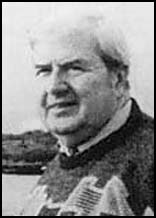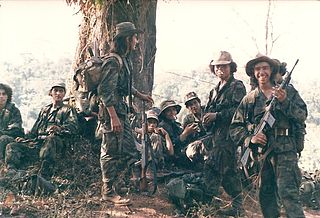Related Research Articles

The Contras were the various U.S.-backed and funded right-wing rebel groups that were active from 1979 to 1990 in opposition to the Marxist Sandinista Junta of National Reconstruction Government in Nicaragua, which had come to power in 1979 following the Nicaraguan Revolution. Among the separate contra groups, the Nicaraguan Democratic Force (FDN) emerged as the largest by far. In 1987, virtually all Contra organizations were united, at least nominally, into the Nicaraguan Resistance.

José Daniel Ortega Saavedra is a Nicaraguan politician who has been President of Nicaragua since 2007. Previously he was leader of Nicaragua from 1979 to 1990, first as coordinator (1979–1985) of the Junta of National Reconstruction, and then as President of Nicaragua (1985–1990). During his first term, he implemented policies to achieve leftist reforms across Nicaragua. In later years, Ortega's left-wing radical politics cooled significantly, leading him to pursue pro-business policies and even rapprochement with the Catholic Church. However, in 2022, Ortega resumed repression of the Church, and has imprisoned prelate Rolando José Álvarez Lagos.

The Iran–Contra affair, often referred to as the Iran–Contra scandal, was a political scandal in the United States that occurred during the second term of the Reagan administration. Between 1981 and 1986, senior administration officials secretly facilitated the illegal sale of arms to Iran, which was subject to an arms embargo at the time. The administration hoped to use the proceeds of the arms sale to fund the Contras, an anti-Sandinista rebel group in Nicaragua. Under the Boland Amendment, further funding of the Contras by legislative appropriations was prohibited by Congress, but the Reagan administration figured out a loophole by secretively using non-appropriated funds instead.
Nicaragua is a nation in Central America. It is located about midway between Mexico and Colombia, bordered by Honduras to the north and Costa Rica to the south. Nicaragua ranges from the Caribbean Sea on the nation's east coast, and the Pacific Ocean bordering the west. Nicaragua also possesses a series of islands and cays located in the Caribbean Sea.

The Republic of Nicaragua v. The United States of America (1986) was a case where the International Court of Justice (ICJ) held that the U.S. had violated international law by supporting the Contras in their rebellion against the Sandinistas and by mining Nicaragua's harbors. The case was decided in favor of Nicaragua and against the United States with the awarding of reparations to Nicaragua.

The Sandinista National Liberation Front is a left-wing political party in Nicaragua. Its members are called Sandinistas in both English and Spanish. The party is named after Augusto César Sandino, who led the Nicaraguan resistance against the United States occupation of Nicaragua in the 1930s.
The Boland Amendment is a term describing two U.S. legislative amendments between 1982 and 1984, both aimed at limiting U.S. government assistance to the Contras in Nicaragua. The first Boland Amendment was part of the House Appropriations Bill of 1982, which was attached as a rider to the Defense Appropriations Act of 1983, named for the Massachusetts Democrat, Representative Edward Boland, who authored it. The House of Representatives passed the Defense Appropriations Act 411–0 on December 8, 1982, and it was signed by President Ronald Reagan on December 21, 1982. The amendment outlawed U.S. assistance to the Contras for the purpose of overthrowing the Nicaraguan government, while allowing assistance for other purposes.

Félix Ismael Rodríguez Mendigutia is a Cuban American former Central Intelligence Agency Paramilitary Operations Officer in the Special Activities Division, known for his involvement in the Bay of Pigs Invasion and the execution of communist revolutionary Che Guevara as well as his close ties to George H. W. Bush during the Iran–Contra affair.
Edén Atanacio Pastora Gómez was a Nicaraguan politician and guerrilla who ran for president as the candidate of the Alternative for Change (AC) party in the 2006 general elections. In the years prior to the fall of the Somoza regime, Pastora was the leader of the Southern Front, the largest militia in southern Nicaragua, second only to the FSLN in the north. Pastora was nicknamed Comandante Cero.

The Nicaraguan Revolution encompassed the rising opposition to the Somoza dictatorship in the 1960s and 1970s, the campaign led by the Sandinista National Liberation Front (FSLN) to oust the dictatorship in 1978–79, the subsequent efforts of the FSLN to govern Nicaragua from 1979 to 1990, and the Contra War, which was waged between the FSLN-led government of Nicaragua and the United States–backed Contras from 1981 to 1990. The revolution marked a significant period in the history of Nicaragua and revealed the country as one of the major proxy war battlegrounds of the Cold War, attracting much international attention.
The La Penca bombing was a bomb attack carried out in May 30, 1984 at the remote outpost of La Penca, on the Nicaraguan side of the border with Costa Rica, along the San Juan River. It occurred during a press conference convened and conducted by Edén Pastora, who at the time was the leader of a Contra guerrilla group fighting against the ruling Sandinista regime in Nicaragua. Pastora, the presumed target of the attack, survived the bombing, but seven other people were killed, including three journalists, and several others were severely injured. The bombing was carried out by an operative posing as a news photographer and is considered a serious violation of journalistic neutrality during an armed conflict, like the assassination in 2001 of Afghan leader Ahmad Shah Massoud by Al-Qaeda agents posing as international journalists.

Thomas Gregory Clines was an American covert operations officer for the Central Intelligence Agency, and a prominent figure in the Iran-Contra Affair.

Enrique Bermúdez Varela, known as Comandante 380, was a Nicaraguan soldier and rebel who founded and commanded the Nicaraguan Contras. In this capacity, he became a central global figure in one of the most prominent conflicts of the Cold War.
American foreign policy during the presidency of Ronald Reagan (1981–1989) focused heavily on the Cold War which was rapidly intensifying. The US government pursued a policy of containment and rollback with regards to communist regimes. The Reagan Doctrine operationalized these goals as the United States offered financial, logistical, training, and military equipment to anti-communist opposition in Afghanistan, Angola, and Nicaragua. He expanded support to anti-communist movements in Central and Eastern Europe.
Operation Charly, was allegedly the code-name given to a program during the 1970s and 1980s undertaken by the junta in Argentina with the objective of providing military and counterinsurgency assistance to right-wing dictatorships and insurgents in Central America. According to Noam Chomsky, the operation was either headed by the Argentine military with the agreement of the United States Department of Defense, or was led by the US and used the Argentinians as a proxy.

Friendly bilateral relations now exist between Nicaragua and the United States. However, in the 19th and 20th centuries, tensions were high and American intervention was frequent. In the 1980s, due to Red Scare paranoia and an attempt to put down socialism in the region, the U.S proceeded to wage an undeclared war against the left-wing Sandinista movement by funding the Contra groups until it was defeated in the election in 1990.

CIA activities in Nicaragua have been ongoing since the 1980s. The increasing influence gained by the Sandinista National Liberation Front, a left-wing and anti-imperialist political party in Nicaragua, led to a sharp decrease in Nicaragua–United States relations, particularly after the Nicaraguan Revolution. In 1981, President Ronald Reagan authorized the Central Intelligence Agency to support the Contras, a right-wing Nicaraguan political group to combat the influence held by the Sandinistas in the Nicaraguan government. Various anti-government rebels in Nicaragua were organized into the Nicaraguan Democratic Force, the first Contra group, at the behest of the CIA. The CIA also supplied the Contras with training and equipment, including materials related to torture and assassination. There have also been allegations that the CIA engaged in drug trafficking in Nicaragua.
In 1979, the Sandinista National Liberation Front (FSLN) overthrew Anastasio Somoza Debayle, ending the Somoza dynasty, and established a revolutionary government in Nicaragua. Following their seizure of power, the Sandinistas ruled the country first as part of a Junta of National Reconstruction. Following the resignation of centrist members from this Junta, the FSLN took exclusive power in March 1981.

Corporate Air Services HPF821 was a transport aircraft delivering weapons via clandestine airdrop to the Nicaraguan Contras which was shot down over Nicaragua on 5 October 1986 by a surface-to-air missile. Two U.S. pilots, Wallace "Buzz" Sawyer and William Cooper, and the Nicaraguan nationalist radio operator Freddy Vilches died when the Fairchild C-123 Provider was shot down by a Sandinista soldier using an SA-7 shoulder-launched missile, while Eugene Hasenfus, the U.S. "kicker" responsible for pushing the cargo out of the aircraft, survived by parachuting to safety. The aircraft was carrying "60 collapsible AK-47 rifles, 50,000 AK-47 rifle cartridges, several dozen RPG-7 grenade launchers and 150 pairs of jungle boots".
The United States has at various times in recent history provided support to terrorist and paramilitary organizations around the world. It has also provided assistance to numerous authoritarian regimes that have used state terrorism as a tool of repression.
References
- 1 2 3 4 5 "Shultz Denies U.S. Link to Plane Downed in Nicaragua: Three Dead, Survivor Is From Wis". Los Angeles Times. October 7, 1986. Retrieved July 28, 2020.
- 1 2 3 4 5 6 7 "Nicaragua Downs Plane and Survivor Implicates C.I.A". The New York Times. October 12, 1986. Retrieved June 7, 2008.
- 1 2 3 4 "Hasenfus Tempers Comments on CIA". The New York Times. November 3, 1986. Retrieved June 7, 2008.
- 1 2 3 4 5 LeoGrande, William F. (2009). Our Own Backyard: The United States in Central America, 1977–1992. University of North Carolina Press. pp. 477–480. ISBN 9780807898802.
- ↑ Omang, Joanne; Wilson, George C (October 9, 1986). "Questions About Plane's Origins Grow". Washington Post.
- ↑ Miller, Marjorie (October 28, 1986). "Nicaragua Gets More Soviet Arms : Copters, Missiles Boost Arsenal for War With Contras". Los Angeles Times. Retrieved November 7, 2021.
- ↑ Crandall, Russell (May 23, 2016). The Salvador Option: The United States in El Salvador, 1977–1992. Cambridge University Press. p. 398. ISBN 978-1-316-48343-5.
- ↑ "Plane Downed In Nicaragua Had Colorful Past". Associated Press . October 9, 1986.
- 1 2 3 4 Miller, Marjorie (November 16, 1986). "Hasenfus Receives 30-Year Sentence : American Gets Maximum Penalty After Nicaragua Terrorism Conviction". LA Times . Retrieved June 26, 2017.
- 1 2 McPherson, Alan L. (2006). Intimate Ties, Bitter Struggles: The United States and Latin America Since 1945. Potomac Books. pp. 102–110. ISBN 9781574888751.
- 1 2 Armstrong, Scott (1990). "Iran-contra: Was the press any match for all the president's men?". Columbia Journalism Review . 29 (1).
- ↑ Furlong, William L. (Summer 1987). "Costa Rica: Caught between Two Worlds". Journal of Interamerican Studies and World Affairs. 29 (2): 119–154. doi:10.2307/166075. JSTOR 166075.
- ↑ "Hasenfus Sentence Confirmed". New York Times. December 12, 1986. Retrieved June 26, 2017.
- ↑ Kinzer, Stephen (December 18, 1986). "Hasenfus is Freed by Nicaraguans and Heads Home". New York Times. Retrieved June 26, 2017.
- ↑ Hasenfus v. Secord, 962F.2d1556 (1992).
- ↑ "The exposure of Eugene Hasenfus". The Tico Times | Costa Rica News | Travel | Real Estate. October 6, 2014. Retrieved September 14, 2021.
- ↑ "Thirty years ago Wednesday, Eugene Hasenfus sparked Iran-contra probe into U.S.-funded terrorism". Daily Kos. Retrieved September 14, 2021.